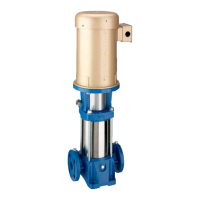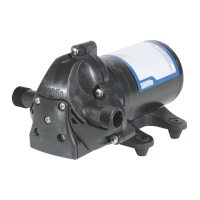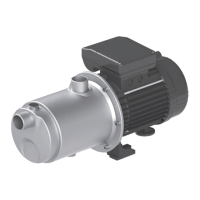VERTICAL MULTISTAGE PUMPS
14
4. Clean the seal seat with a wet cloth.
5. Remove the rotating parts of the seal by twisting and pulling
up on them until they come off the shaft (15C and 15D, 15E,
15F, and 15G). Discard the old seal.
SEVEN PART MECHANICAL SEAL REASSEMBLY.
NOTICE: Before assembly check and clean all sealing and
gasket surfaces with a clean wet cloth. Replace all seals, gaskets
and O-rings.
1. Turn the motor bracket (7) upside down.
2. Moisten the seal seat (in the motor bracket) with a small
amount of water.
3. Lubricate the larger diameter O-ring (15A) with a small
amount of water and install it on the stationary half of
mechanical seal (15B).
4. Press the stationary half of the shaft seal (15B) with O-ring
(15A and 15B) into the seal seat of the motor bracket. Use
finger pressure only. If a tool is used, protect the seal face
from tools with a clean cloth.
NOTICE: Be sure the seal is installed evenly to avoid
pinching the O-ring.
5. Lubricate smaller diameter O-ring (15D) with water and
press it into the rotating half of the mechanical seal (15C).
6. Install the mechanical drive ring (15G) on the shaft (16A).
Be sure the drive ring butts up against the mechanical seal
spacer (16C).
7. Install the spring (15F) up against the drive ring on the shaft.
8. Install the flatwasher (15E) on the shaft, against the spring.
9. Install the rotating half of the mechanical seal (15C) on
the shaft. Align the grooves on the rotating half of the
mechanical seal with the teeth on the mechanical drive ring
(15G).
10. Follow steps 11–23 under Replacing Pump Stack.
FREQUENCY OF STARTS AND STOPS. Check pump cycling
frequency and make sure that the pump is not starting more than:
TABLE IX – Maximum Number of Cycles
Cycles Motor HP Rating
20 times per hour 1/2 – 5 HP motors
15 times per hour 7- 1/2 – 15 HP motors
10 times per hour 20 and 25 HP motors
FROST PROTECTION.
1. If you do not use your pump during seasons of frost, drain it
and add a glycol based antifreeze (50/50 mixture) to avoid
damage.
2. Upon restart dispose of spent antifreeze properly.
3. Do not replace the drain plug or tighten the priming plug
until you put the pump back in service again.
REGULAR MAINTENANCE CHECKS. The following checks
should be made at regular intervals:
1. The pump meets required performance and is operating
smoothly and quietly.
2. There are no leaks.
3. The motor is not overheating.
4. Remove and clean all strainers and filters in the system.
5. Verify amp draw – check motor amperage.
6. Pump wear rings and shaft require no regular maintenance.
TABLE VIII – Torque Specifications (foot-lbs.) For Cast Iron and Stainless Steel Models
Pump Model
Number
Coupling Motor Staybolt Stack Nut
Socket Head Screw Hex Head Capscrew Hex Nut Hex Nut
M6 x 20 M8 x 25 M10 x 25
3/8
x 1-1/2
1/2
x 1-1/2
1/2 - 13 5/8 - 11 M8 M12
PVM2 Series 15 20 – 30 35 40 – 10 –
PVM4 Series 15 20 – 30 35 40 – 10 –
PVM8 Series 15 20 45 30 35 – 45 – 30
PVM16 Series – 20 45 – 35 – 45 – 30
Caution: Risk of Water Damage and Injury
Watch the direction of the priming plug and make sure
that liquid escaping from it does not injure persons nearby
or damage the motor or other components. In hot water
installations, pay particular attention to the risk of injury from
scalding hot water.

